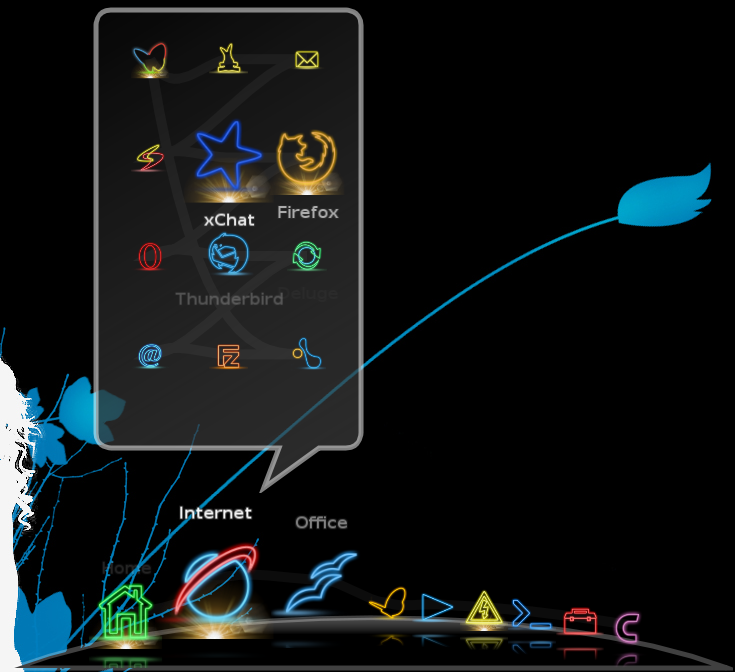 Cairo-Dock is an animated application launch bar for the desktop, comparable to the dock in Mac OS X or Rocket Dock (for Windows). Now, you can use Cairo-Dock with OpenGL (to use your graphic card!). Some screenshots
Cairo-Dock is an animated application launch bar for the desktop, comparable to the dock in Mac OS X or Rocket Dock (for Windows). Now, you can use Cairo-Dock with OpenGL (to use your graphic card!). Some screenshots
It is compatible with Compiz-Fusion, Beryl, Compiz, Metacity, Kwin, Xcompmgr, etc., but it can also run without a composite manager (using fake transparency). Cairo-Dock can run under GNOME, KDE and XFCE.
This page only describes how to install Cairo-Dock and some basic usage instructions. If you want to know more about configuration and themes you should go to the Cairo-Dock website, its wiki and read this tutorial. The site is in French and in English, the wiki has a complete English section and don't be afraid to ask questions or report bugs in the forum.
Installation.
The project is split in to two parts: the dock itself and the plug-ins. Only the installation of the dock is explained, but installing the plug-ins is the same, just make sure you install the plug-ins after the dock.
The config file will not be overwritten during updates as Cairo-Dock is capable of inserting the missing fields if any without losing your previous settings.
Please note that, although Cairo-Dock is listed in the Universe repository since Ubuntu 8.10 (Intrepid Ibex) and can be installed using Synaptic Package Manager, but it is recommended to install Cairo-Dock using one of the methods described below to get the most up-to-date and stable version of Cairo-Dock.
From the Repository (Stable).
This is only for Ubuntu 8.04 (Hardy Heron), Ubuntu 9.04 (Jaunty Jackalope), Ubuntu 9.10 (Karmic Koala) and Ubuntu 10.04 (Lucid Lynx) with a support of 32/64bit/lpia architecture.
With 5 commands.
To add the Cairo-Dock repository to your sources simply launch these commands from a terminal :
<big><i>sudo -v</i></big>
<big><i>echo "deb http://repository.glx-dock.org/ubuntu $(lsb_release -sc) cairo-dock ## Cairo-Dock-Stable" | sudo tee -a /etc/apt/sources.list <br />wget -q http://repository.glx-dock.org/cairo-dock.gpg -O- | sudo apt-key add - <br />sudo apt-get update <br />sudo apt-get install cairo-dock cairo-dock-plug-ins</i></big>
Manually.
Or if you want to do that manually, open the sources.list file:
<big><i>gksudo gedit /etc/apt/sources.list</i></big>
and add the appropriate repository to the end of the file:
<big><i>deb http://repository.glx-dock.org/ubuntu lucid cairo-dock # For Ubuntu 10.04<br /><br />deb http://repository.glx-dock.org/ubuntu karmic cairo-dock # For Ubuntu 9.10<br /><br />deb http://repository.glx-dock.org/ubuntu jaunty cairo-dock # For Ubuntu 9.04<br /><br />deb http://repository.glx-dock.org/ubuntu hardy cairo-dock # For ubuntu 8.04<br /><br /></i></big>
The signed GPG key for identification of the repository is:
<i><big>wget -q http://repository.glx-dock.org/cairo-dock.gpg -O- | sudo apt-key add -<br /><br /></big></i>
Then, to install Cairo-Dock, issue these two commands in the terminal:
<big><i>sudo apt-get update<br />sudo apt-get install cairo-dock cairo-dock-plug-ins<br /><br /></i></big>
There are no repositories available for releases older than Ubuntu 8.04 (Hardy Heron). So, if you want Cairo-Dock for an older release, you must compile it or download the package.
From a .deb Package (Stable).
If you can't install Cairo-Dock from the repository, you can download the .deb package from LauncHPad. But you first need to install the following packages:
<big><i><br />sudo apt-get install libcairo2 librsvg2-2 libglitz1 libglitz-glx1</i></big>
Then, download the packages here.
Apply a double-click on the package or open the terminal, navigate to the directory which you downloaded the .deb package to (e.g. cd ~/Desktop) and issue the following commands (NB: Ensure that you have typed in the correct version number):
<big><i>sudo dpkg -i cairo-dock*.deb</i></big>
and then:
<big><i>sudo apt-get -f install</i></big>
Done. You can type cairo-dock in terminal to launch and configure the dock.
By Compiling it (Stable).
First you must install the following packages:
<big><i>sudo apt-get install build-essential libcairo2-dev libgtk2.0-dev librsvg2-dev libglitz1-dev libcairo2 librsvg2-2 libglitz1 <br />libglitz-glx1 libglitz-glx1-dev m4 autotools-dev pkg-config libtool</i></big>
Then, download the tar.bz2 package from Launchpad : core package here and its plug-ins here. Open the terminal and navigate to the download directory and type:
<big><i>autoreconf -isvf<br />./configure –prefix=/usr<br />make<br />sudo make install</i></big>
By Compiling it With a Script Using the bazaar (Unstable).
If you want to try the newest version of Cairo-Dock (not in the repository because it's not completely stable), you can use the BZR. But be aware that this version is potentially unstable and there are updates everyday. Use this version only if you know what you're doing, it is also preferable to know how Cairo-Dock works to be able to use the BZR.
A script has been written to compile the BZR version of Cairo-Dock easily. So, you just have to create a directory where the script will be installed in, download the script and launch it:
Open a terminal, and create a new directory:
mkdir /cairo-dock_bzr<br />cd /cairo-dock_bzr
Then get the script, make it executable and launch it:
wget http://bzr.glx-dock.org/cairo-dock_bzr.sh<br />chmod u+x cairo-dock_bzr.sh<br />./cairo-dock_bzr.sh
Simply follow the instructions (in English)
To finish, enter your own password when prompted by the script in order to proceed with to the installation.
A line will appear after the installation of each module and a final message will appear indicating that everything went well. If not, consult the log.txt file in the directory you have created at the beginning. Look at the end to locate the problem, then post it in the forum.
What is installed?
Cairo-Dock stores your launchers and your parameters in a hidden directory, ~/.config/cairo-dock
Also, binaries are in /usr/bin and data (including the default themes) in /usr/share
First Launch.
If you installed Cairo-Dock from the packages, there should be a launcher in the applications menu, under the System Tools sub-menu. If there isn't a launcher there, just press Alt+F2 and type in cairo-dock. To enable backtraces on launch (sometimes useful if a problem occurs), open a terminal and type cairo-dock & disown and press enter.
On first launch, Cairo-Dock will configure itself and will offer you a list of themes to choose from. This allows you to have a fully functional dock immediately. You will have to move the mouse cursor to the bottom of the screen to see the dock if auto-hide has been enabled. This depends on the theme you chose at launch.
If you want to use another theme, right click on the dock and select Cairo-Dock > Manage Themes. To configure the dock's settings, right click the dock and select Cairo-Dock > Configure.
REM: Cairo-Dock has now a support of OpenGL. If you want to use it automatically, simply launch Cairo-Dock with cairo-dock -o. Note that the OpenGL for Intel and ATI is not so great except with Ubuntu Karmic or newer (have a look the wiki of Cairo-Dock.)Screenshots.
O visión Parabólica:





0 commenti:
Post a Comment